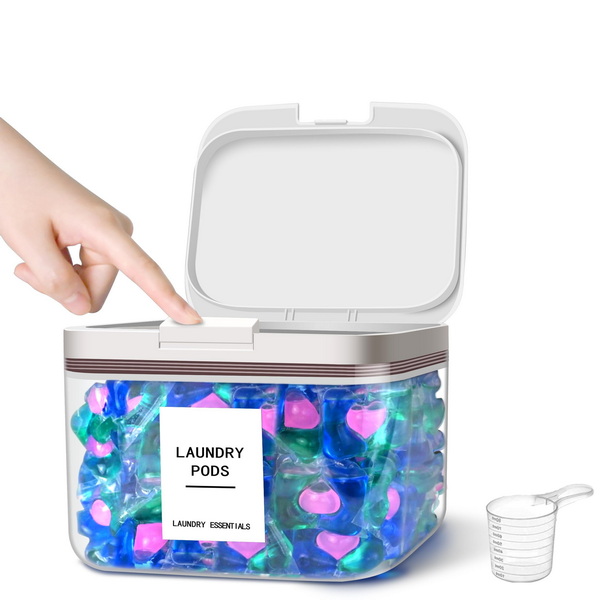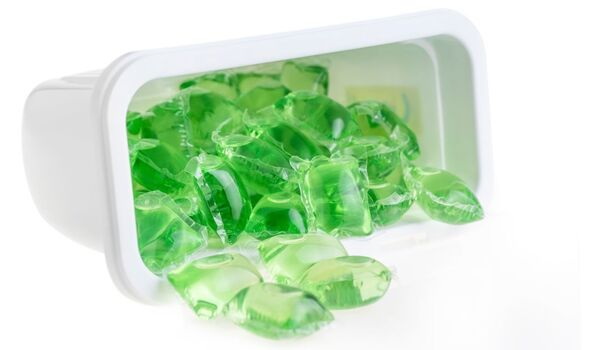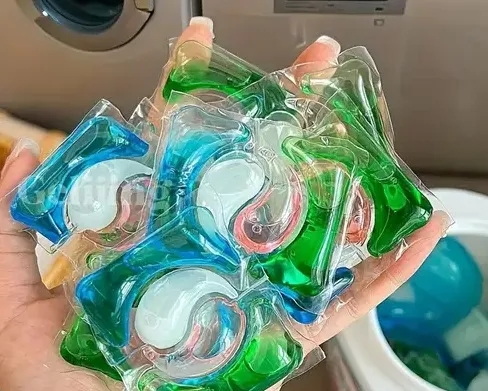Dongguan UFine Daily Chemical Co.,Ltd.
- All
- Product Name
- Product Keyword
- Product Model
- Product Summary
- Product Description
- Multi Field Search
Views: 222 Author: Tomorrow Publish Time: 11-17-2025 Origin: Site











Content Menu
● Understanding Laundry Powder and Pods
● Cleaning Effectiveness in Different Situations
● Cost Comparison and Economic Perspective
● Convenience and User Experience
● Impact on Washing Machines and Maintenance
● Environmental and Sustainability Considerations
● Energy Efficiency and Water Temperature
● Environmental Footprint in Manufacturing
● Comparing Packaging Waste and Recycling
● Future Trends in Laundry Detergents
● FAQs
>> 1. Are laundry pods as effective as powder detergent for stain removal?
>> 2. Can laundry pods be used in all washing machines?
>> 3. Is laundry powder better for the environment than pods?
>> 4. Do laundry pods expire faster than powder?
>> 5. Which type saves more energy during washing?
Laundry cleaning has evolved rapidly, with new technologies transforming how people wash clothes. Among the most debated topics is whether laundry powder is better than pods. Consumers often ask which option delivers the best cleaning power, value, and eco-friendliness. Each has devoted users for good reasons, but understanding their distinctions can help make smarter laundry decisions.

Laundry powder remains the traditional detergent format. These granular formulations combine surfactants, builders, enzymes, and sometimes bleaching agents to lift stains and brighten fabrics. They have long been favored for their affordability, versatility, and accessibility.
Laundry pods, introduced in the early 2010s, represent modern cleaning convenience. Each pod is a small, pre-measured capsule containing concentrated liquid detergent encased in water-soluble film. Once dropped into the drum, the film dissolves, releasing detergent during the wash cycle. Pods appeal to busy households, students, and people seeking simplicity without measuring detergent manually.
Laundry powders often contain alkaline builders such as sodium carbonate and percarbonate. These help break down organic stains like mud, sweat, and blood while softening hard water. Many powder detergents also include enzymes and bleach for deep cleaning.
Pods carry a highly concentrated blend of liquid surfactants, enzymes, and brighteners. Because of this concentration, pods dissolve quickly and start cleaning rapidly, even in cold water. Some brands also include color-protecting or fabric-softening ingredients, offering an all-in-one cleaning experience.
Despite formulations being equally effective in many cases, the method of delivery changes results. Pod concentration ensures consistent performance but limits customization. Powder lets users adjust dosage based on load size or dirt intensity, making it more flexible for varied washing conditions.
Powder detergents perform well on heavily soiled clothes and work uniforms where deep stains require strong action. The higher alkalinity and presence of bleach make them especially effective for white fabrics. In contrast, pods shine in daily use for mixed-color clothing and delicate fabrics, where gentle action reduces fading and fiber stress.
In very hard water regions, powder's builders are beneficial because they bind calcium and magnesium ions that interfere with cleaning. Pods, although effective, might need soft water to perform at full potential. Some users combine pods with separate softening agents for optimal results.
Cost per wash remains a decisive factor for many consumers. Powder detergent, sold in bulk boxes or large bags, generally costs less per load. Economies of scale make powder ideal for large families or institutions such as hotels or laundromats.
By comparison, pods have a higher unit cost because of individual packaging and the technology behind encapsulation. However, because pods eliminate over-pouring, waste is minimal. Consumers unwilling to measure detergent each time may ultimately use fewer pods than the equivalent extra scoops of powder.
A balanced view shows that while powder is more economical upfront, pods offer long-term savings through controlled dosing, lower water temperature needs, and reduced detergent waste.
Convenience heavily influences modern purchasing choices. Pods offer one-step simplicity: toss a capsule into the drum and start the wash. This design minimizes spills, sticky residue around detergent drawers, and product waste.
For laundry powder, precise measurement is necessary. Although scooping becomes second nature for experienced users, it can be messy and time-consuming for others. However, using powder allows greater adaptability. Users can dose extra for larger loads or less for small batches, ensuring efficient detergent use.
Households with shared laundry facilities often prefer pods because of portability and hygiene. Meanwhile, households washing large volumes may stick with powder for practicality and affordability.
Laundry product choice can influence machine lifespan. Undissolved powder residues may accumulate inside dispensers or pipes, especially with cold water washing. Over time, these deposits could cause unpleasant odors or minor clogging.
Pods dissolve entirely in most modern washers when used correctly. Yet, if loaded improperly or exposed to damp conditions before the wash, the film may partially dissolve and stick to fabrics. Using pods in dry, low-humidity storage and placing them directly in the drum avoids such issues.
Routine washing-machine cleaning, including high-temperature maintenance cycles, removes deposits from both powder and pod detergents. Ensuring machine care reduces repair costs and maintains peak performance.

Environmental footprint plays an increasingly vital role in detergent selection. Powder detergents often use simple cardboard boxes or paper-based packaging, which are recyclable and produce minimal plastic waste. Additionally, many brands now emphasize low-phosphate or phosphate-free formulations, important for protecting aquatic life.
Pods rely on polyvinyl alcohol (PVA) film to encapsulate detergent. The film dissolves in water, but complete biodegradability outside controlled conditions remains debated. Although modern manufacturers create improved versions of PVA, consumers concerned about microplastic pollution sometimes prefer powders.
Furthermore, powders require higher manufacturing energy due to their weight and volume, whereas pods' concentrated design saves shipping space and potentially lowers carbon emissions. Overall sustainability depends heavily on sourcing, packaging, and individual washing habits.
Different detergents affect fabric life differently. Powder detergents, enriched with bleach and strong surfactants, excel at stain removal and whitening. However, overuse or washing delicate clothes with powder may cause fiber damage or fading.
Pods, with balanced liquid formulas, provide gentler care, making them suitable for blends, synthetics, and colored fabrics. Their controlled detergent release avoids harsh chemical exposure. For anyone focused on prolonging garment lifespan, pods often deliver consistently gentle results.
That said, modern powder formulations offer low-foam, enzyme-rich options designed specifically for sensitive fabrics, bridging the historical gap in softness and color care.
Safety, especially in households with young children, deserves attention. Pods' bright appearance has caused accidental poisonings in several countries since their introduction. To address this, manufacturers adopted opaque packaging and child-resistant locks. Families should always store pods in secure, elevated locations.
Powder detergents pose less ingestion risk but may irritate skin, eyes, or lungs if mishandled. Users should avoid prolonged inhalation of fine dust when pouring powder and wash hands afterward. Wearing gloves helps prevent skin dryness or allergic reactions.
By following safety guidelines, both products can be stored and used responsibly without health hazards.
Powders last for years when kept dry. Moisture causes clumping, reducing solubility, although cleaning performance often remains acceptable. Storing powder in sealed containers prolongs its life and ensures easy handling.
Pods are sensitive to humidity and temperature. Exposure to excess moisture can cause the capsules to stick together or rupture. Manufacturers recommend airtight, cool storage, ideally away from washing machine heat.
Shelf-life differences are significant for bulk users. Powders may remain usable far beyond a year, while pods should typically be used within six to nine months after opening.
Households seeking energy savings often turn to cold-water washing. Pods are optimized for cold-water solubility, dissolving even in low temperatures. This not only saves energy but also protects bright colors and delicate fabrics.
In contrast, powder detergents perform best in warm water because certain ingredients, especially bleaching agents, activate under heat. However, many new formulas have improved to dissolve in cooler temperatures, closing the efficiency gap.
Overall, pods tend to win for consistent cold-water dissolution, while powder remains dominant in heavy-duty, warm-water cycles.
Powder and pod production differ greatly in industrial processing. Powder mixing involves dehydration, spray-drying, and granulation—energy-consuming but relatively straightforward steps. Pod manufacturing uses encapsulation technology requiring controlled humidity, film handling, and precision dosing.
Pods therefore involve higher manufacturing cost but deliver concentrated formulas with less water content. Producer sustainability goals, including renewable energy use and recyclable packaging design, are key to offsetting production effects. Many global companies continue innovating for lower-carbon, biodegradable detergent options.
Powder packaging is often easier to recycle and reuse since cardboard decomposes efficiently. In some markets, refill systems for powder have appeared, reducing packaging waste significantly.
Pods' plastic containers are harder to recycle due to mixed materials and safety labels. However, eco-brands now experiment with compostable containers or refill pouches that reduce total plastic use. The choice can reflect personal values: convenience lovers may prefer pods, while zero-waste advocates often choose powder.
The detergent industry is moving toward sustainability, transparency, and concentrated efficiency. Formulas are becoming low-suds, plant-derived, and phosphate-free to meet modern green standards. Consumer demands now influence innovations that bridge gap between powder reliability and pod convenience.
Smart washing machines also influence detergent use. Some machines automatically dispense concentrated detergent from built-in cartridges, making format differences less important. However, traditional powders and pods remain highly relevant due to cost, accessibility, and global distribution.
Ultimately, the better detergent depends on your lifestyle and priorities:
- Choose powder for affordability, stain removal, and large volume washing.
- Choose pods if you value convenience, dosing precision, and fabric care.
- Powder suits families or commercial users with heavy laundry demands.
- Pods fit small households seeking clean, effortless washes.
Neither option is universally superior. Instead, each offers advantages under specific circumstances.
The debate over whether laundry powder is better than pods reflects changing lifestyles and environmental awareness. Powder remains a reliable, cost-effective, and powerful cleaning solution, ideal for bulk washing, whites, and stubborn stains. Pods excel in modern convenience, precise dosing, and cold-water performance. The ultimate choice varies by individual priorities such as cost, fabric care, sustainability, and washing frequency. A mindful, informed approach ensures clean clothes, lower waste, and long-lasting fabrics in every load.

Pods clean common stains efficiently, but powder offers superior performance for tough stains due to added bleaching agents and higher alkalinity.
Yes, pods are compatible with both front- and top-loading machines. Place them directly inside the drum to ensure complete dissolution.
Powder usually has a lower environmental impact because of recyclable packaging. However, advanced eco-pods now close this gap with biodegradable coatings and plant-based ingredients.
Yes, pods react to moisture and temperature, reducing shelf life. Powders last longer if kept in airtight, dry containers.
Pods often save energy by dissolving effectively in cold water. Powder performs best in warm or hot cycles but can also be used in efficient modern washers.